 S.J. Kincaid
S.J. KincaidSimon & Schuster, 2016 403 pgs.
Grades 9-Up
Science Fiction
Nemesis was genetically created to be a fighting machine, protecting the wealthy person who purchases her to the death. Sidonia is Nemesis' owner on whom she imprinted. Sidonia and Nemesis forge a bond and Sidonia refuses to give up her friend, even when Diabolics become unlawful. When Sidonia is called to the royal court by the corrupt and evil emperor because of her father's heretic ways, the family panics. Instead of sending Sidonia, they send Nemesis posing as the young royal. Nemesis travels to the far off planet of the court where she makes her first friend and learns to navigate the ways of the rich and powerful. The emperor in order to secure his authority over citizens wanting to embrace science and learning, wipes out all of those who pose a threat. This includes Sidonia and her family. Nemesis is devastated. In her grief she befriends Tyrus, the seemingly insane nephew of the emperor and the heir to the throne. The two form an uneasy alliance that evolves to feelings of possible romance. Tyrus wants to overthrow his corrupt uncle and restore the kingdom to that of learning and environmental and humane protection, while Nemesis merely seeks revenge. The two allies calculate a plan which involves deception, inter-planet travel, and extreme danger. Alliances are questioned and players fall as Nemesis learns to think for herself and process emotions that she has never allowed herself to harbor.
Kincaid offers another dystopian novel in a very crowded market, yet manages to find a fresh niche within the genre. Instead of characters running around a decaying earth, The Diabolic is more "sci-fi" than the average dystopian book for teens and is set in outer space with planets long since colonized and space travel the norm. Kincaid visits the end of a civilization ravaged by environmental neglect and gluttony, delivering a cautionary tale to today's youth. The novel is written in the first person and we see inside the head of Nemesis as she learns to navigate an unfamiliar world and how to process feelings and make decisions. The character of Nemesis is unusual and interesting. The romance between her and Tyrus is not totally believable, but adds a crucial element for teen readers and provides motivation for plot development. A love triangle presents itself in an unexpected way, which proves interesting. In fact, there were many surprises and plot twists in the book that made it exciting to read and helped to keep the pages turning. Kincaid knows how to end a chapter with a cliff hanger and is not afraid to delve into extreme violence, making the book more appropriate for older teens. Beyond the environmental message, other themes include loving and excepting the person that you are, overcoming abuse from the past, and the importance of loyalty and trust. Nemesis is a powerful woman, physically stronger than her love interest, which is a positive role model for young women, although she does struggle emotionally. Even though its at opposite ends of the timeline, give to fans of Sabaa Tahir and Sarah Maas. An exciting and enjoyable read sure to be popular with teens.





